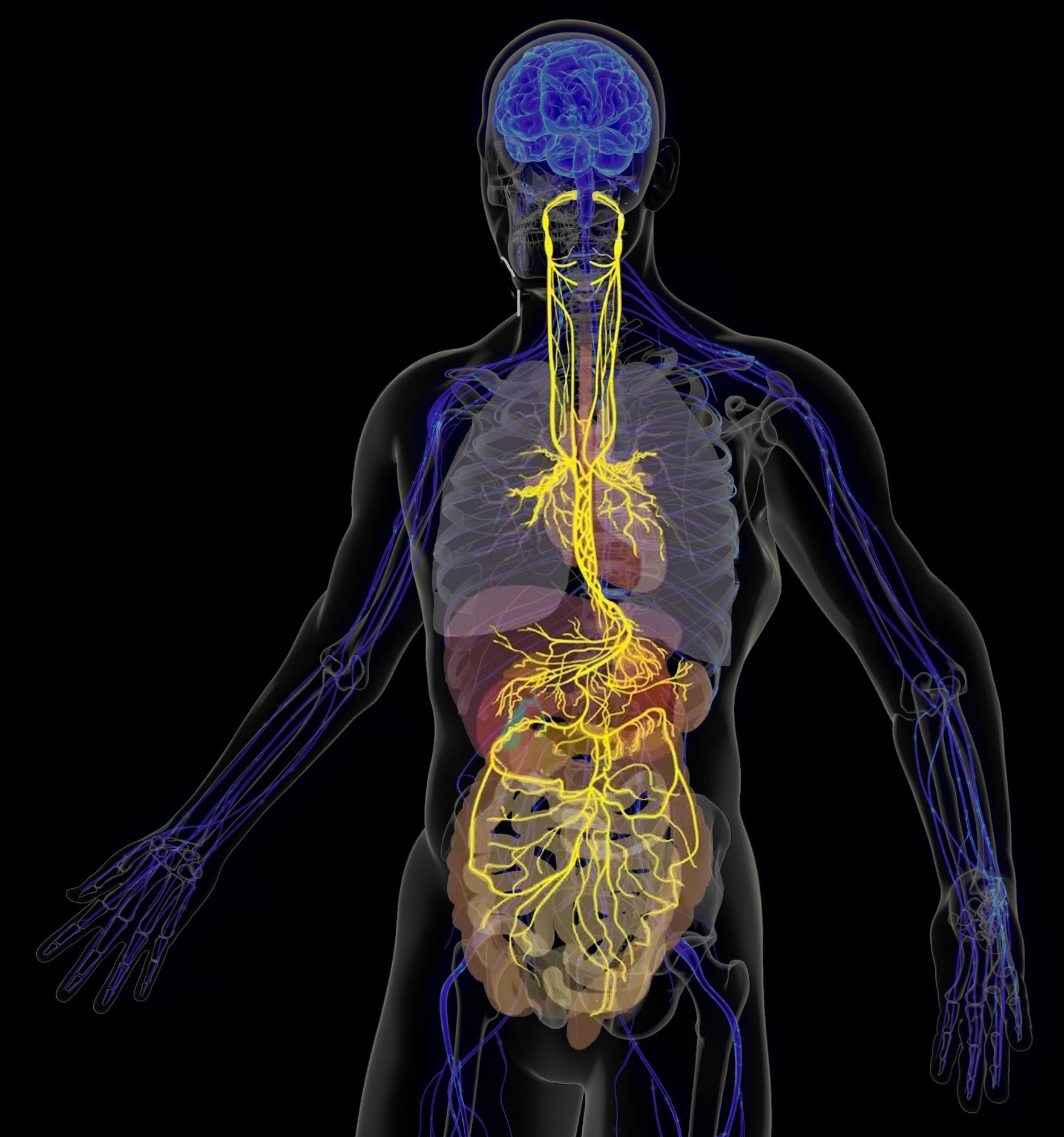Most of you are probably wondering… what is the vagus nerve?
The vagus nerve is the 10th cranial nerve and the most important nerve in the body! The term vagus means to wander. This system of nerves wanders throughout your body, connecting everything from your eyes to your lungs, heart, stomach, and intestines.

What does the vagus nerve do?
The vagus nerve collects information and delivers it, functioning as a two-way information highway to the brain, instructing the body’s biochemistry at every moment. It is the software that tells your hardware, or organs, what to do. It is also one of the few nerves that control sensory and motor functions. This nerve system carries 75% of the cranial parasympathetic functions.
Let’s talk about the sympathetic and the parasympathetic nervous system.
The sympathetic system is your fight, flight, or freeze response system. The parasympathetic system is part of the automatic nervous system controlling your heart rate, blood pressure, digestion, urination, sweating, and other functions you don’t think about. You access the full power of your parasympathetic nervous system when you are in a calm state, allowing your body to repair, heal, and function optimally. The parasympathetic state is when the vagus nerve can really do its job.
Both the sympathetic and parasympathetic systems are necessary and play complementary roles, but they can’t work at the same time. Dr. Jamndas points out you are either functioning on an AC or DC current, you can’t do both at the same time, or you’ll get a short circuit. Think about a computer running constantly, with ten tabs and five applications open. It is going to overheat. We all need to take time to shut down, reset, and reboot. And our vagus nerve helps with that.

It is easy to let life’s daily stresses overtake us, but hacking the vagus nerve to find a state of ease is primal. If a lion is chasing an antelope, the antelope is in the sympathetic state of survival. But when the threat of the lion has disappeared, the antelope goes right back to eating grass. It doesn’t dwell or hold on to that stress, making its way back to a parasympathetic state, allowing itself to recover and reset. It’s about learning how to control switching from survival mode to optimal functioning mode.
When you don’t spend time resetting or toning your vagus nerve, it can lead to a multitude of problems with all the organs it sends commands to.
- It can lead to increased heart rate and high blood pressure. When you are stressed out, your platelets get sticky, which can lead to blood clots.
- You can have issues digesting your food when your stress levels aren’t being managed. Having a healthy gut is important because it is the second largest neural network in your body and is directly connected to the vagus nerve.
- If you have issues with fainting, this can be due to issues with your vagus nerve.
- Having problems sleeping well or getting into a deep sleep leads you to waking up fatigued because, without adequate rest, your vagus nerve won’t be able to turn on. You are basically stuck in buffering mode.
- The vagus nerve controls inflammatory responses, so when it isn’t working properly or being accessed, inflammation continues, which leads to chronic disease.
The good thing is the vagus nerve is the most accessible nerve,
so you can hack and reset it!
Number one is through exercise.
Stressing your body in this way goes back to the complementary relationship of being in a sympathetic state to do a workout or an activity, then switching to a state of ease afterward makes the vagus nerve stronger and better.
You can also stress the body to hack the switch between the sympathetic and parasympathetic state through fasting/time-restricted or sitting in a sauna.

Number two is slow, deep breathing
When doing breathing exercises for the vagus nerve, it is all about the exhalation. Inhaling naturally creates tension and makes everything rise. But when you exhale, that is where the release is. If you inhale for 4 counts or beats, you want to exhale for 8. Also, focus on breathing from your diaphragm. When inhaling, think of filling your lower back and belly with air and actively letting the muscles contract as you exhale.

Number three is through yoga postures.
Yoga trains the mind to be calm while working the body and hacking the vagus nerve. Inversions are the best way to stimulate it and reset it. There are lots of options for inversions that don’t involve headstands. A simple Uttatasana (forward fold), downward facing dog, Uttana Shishosana (extended puppy pose), and bridge pose are other versions of inversion postures. And let us not forget the benefits of savasana (corpse pose). Taking time in this active state of rest, whether it be 5 minutes or 15 minutes, is beneficial to lessen fatigue.






Number four is through experiencing cold water.
This can be as simple as turning the shower to cold for a minute or two. A more fun way is diving into a pool or natural body of water that is at a colder temperature.
If you are in a pinch and can’t do either of those, you can put something cold, like an ice pack or frozen vegetables, to the side of your neck, right below your ear.

Number five is rest.
A solid night of sleep can do wonders for your vagus nerve as you are in a parasympathetic state when you are sleeping. It is when your body heals, repairs, and sets itself up for the next day.

As you can see, hacking the vagus nerve is a simple task that only requires some time and mindfulness. Set daily reminders to do little updates to keep your body’s system running at top performance level.
Happy Hacking!
Watch Dr. Jamnadas’ full video on the topic here:
